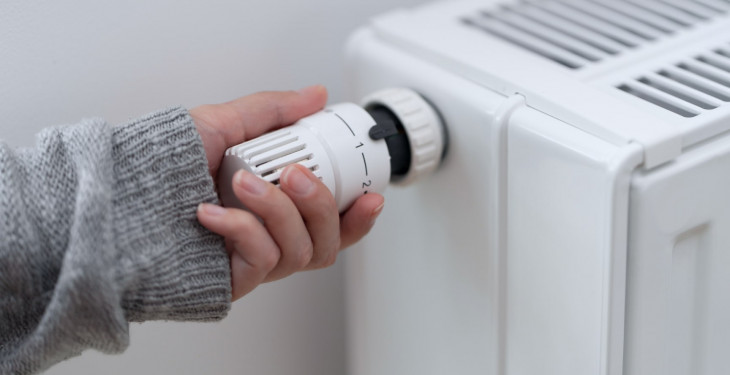
Learn how to balance your radiators to improve heat distribution, boost boiler efficiency, and lower your energy bills with this simple step-by-step guide for UK homes.
Get a new boiler quote, save up to £550 per year (0% APR available).
If your home has cold spots or some radiators heat faster than others, your system likely needs balancing. In this guide, we’ll explain how to balance your radiators, why it matters, and how it helps improve your home’s heating efficiency.
Balancing ensures each radiator in your home receives the correct flow of hot water from your boiler. Without it, radiators closer to the boiler heat quickly while those further away stay cooler. This imbalance wastes energy, increases running costs, and makes your home less comfortable.
We also have a video available which explains exactly how to balance your radiators yourself.
Balancing a radiator means adjusting the flow of hot water through your heating system so each radiator reaches its target temperature at roughly the same time.
It’s done by fine-tuning the lockshield valves (the small capped valves on one end of each radiator). Opening or closing these slightly controls how much hot water flows through each radiator.
These two terms are often confused, but they solve different problems:
Task | Purpose | When to Do It |
|---|---|---|
Bleeding | Removes trapped air so radiators heat at the top | When you hear gurgling or see cold spots at the top |
Balancing | Adjusts water flow for even heating | When some radiators are cooler or slower to heat |
Balancing can take time but is simple with patience. You’ll need a radiator key, adjustable spanner, digital thermometer (or infrared thermometer), and a notepad.
First of all to carry out the initial bleeding and balancing of your radiators you’ll need the following tools:
Bleed key
Screwdriver
Lock-shield valve key or adjustable spanner
Digital thermometer or multimeter with thermometer
Firstly switch off your central heating and allow radiators to cool, as mentioned it’s prudent to have already bled and if need be have carried out a system power flush.
You must fully open the thermostatic valves by turning the valve head to the highest number on the dial, this is usually anti-clockwise (to the left).
If your radiators do not have thermostatic valves, alternatively you can make sure the lock-shields are open by removing the cover cap and turning the valve anti clockwise with a valve key or spanner.

After all of the radiator valves are open, switch the heating back on and monitor the order the radiators heat up in.
Once you’ve made notes on the heating rates, switch the heating fully off and allow radiators to cool back down, before switching the heating back on…we know, but keep soldiering on.
Turn the lock-shield valve on the fastest radiator until it’s completely closed and then open it by a quarter turn.
Firstly, once the fastest radiator has heated up, take an accurate temperature reading (right at the point of connection between the pipework and lock-shield valve).
Then take the temperature of the pipework on the opposite side, where the TRV is found and make a note of both measurements.
Turn the lockshield valve slowly until the difference between the two readings is exactly 12°C
Repeat step 6 on other radiators around the property in order to effectively balance them; often the further the radiator is away from the boiler, the more its lock-shield valve will need to be opened to provide equal water reception, for example the slowest radiator to heat up may require its lock-shield valve being fully opened.
Radiator Location | Flow Temp | Return Temp | Difference | Adjustment |
|---|---|---|---|---|
Living Room | 70°C | 58°C | 12°C | Perfect |
Bedroom | 69°C | 55°C | 14°C | Slightly close valve |
Kitchen | 71°C | 62°C | 9°C | Open valve slightly |
Bathroom | 72°C | 60°C | 12°C | Perfect |
Balancing radiators doesn’t just improve comfort it also helps your boiler work more efficiently. When radiators are balanced, your boiler doesn’t have to overwork to push hot water through unevenly heated circuits.
According to the Energy Saving Trust, improving heating system efficiency can reduce energy bills by up to 10–15%.
Professional radiator balancing typically costs £80–£150, depending on your property size, and can pay for itself through reduced heating bills.
If your radiators are still struggling to heat evenly after balancing, it may be time to consider a power flush or even upgrading to a more efficient A-rated boiler.
If you have thoroughly carried out all the steps in the process as listed above, yet are still having issues, equal water dispersion disparities may be down to other problems.
One prevalent component issue that can lead to radiator imbalance is a faulty pump that isn’t efficiently thrusting water around your central heating system.
Another type of underlying cause of radiators not being balanced is a build up of ‘sludge’ within the system; tell tale signs of sludge presence is thick, dark water escaping from radiators when they’re bled, or cold spots at the bottom of the radiator.
To remedy this issue a system cleanse may need to be carried out via a power flush if one has not been carried out prior to carrying out steps 1-7.

Balancing your radiators ensures every room heats evenly and your boiler runs efficiently. It’s a simple but essential maintenance task that improves comfort and cuts waste.
If you’re unsure or prefer a professional touch, iHeat’s expert engineers can assess and optimise your system during a service or new boiler installation.
References
Energy saving trust - https://energysavingtrust.org.uk/advice/heating-controls
Gas Safe register - https://www.gassaferegister.co.uk/
Last updated: 20th October, 2025

Written by Rick Hope
Managing Director at iHeat
Rick Hope is the Managing Director and Co-Founder of iHeat, leading the company’s mission to simplify boiler and renewable installations across the UK. With a background in digital strategy and business growth.
LinkedInArticles by Rick Hope are reviewed by iHeat’s technical team to ensure accuracy and reliability.

18th December, 2025
An airing cupboard is a heated storage space that uses warmth from a hot water cylinder or...
 Read Article
Read Article

18th December, 2025
Searching for the best boiler brand for terraced housing? Our guide compares the top-rated...
 Read Article
Read Article

18th December, 2025
When your old boiler breaks down and it comes time to replace it with a new one, it might...
 Read Article
Read Article
No obligation. Takes less than 60 seconds.